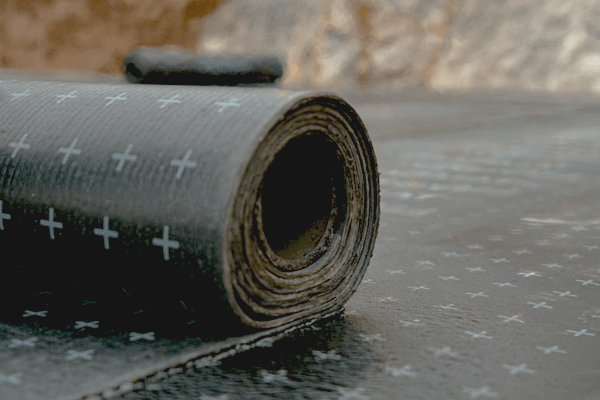Tar paper is usually a heavy-duty type of paper that is used in construction. It is manufactured with impregnable paper or fibreglass mat and tar, creating a waterproof material that is used for constructing roofs. Tar paper has been used for centuries. Tar paper has a water repellent feature that allows it to act as a shield rather than a sponge.
There are primarily three types of roofing underlayment, synthetic roofing felt (Bituminous waterproofing) and tar paper are the common ones. It is vital to choose a good quality roof underlayment as a roof plays a significant role in protecting your home from any kind of outside threat or damage. In this article, we will discuss tar paper and synthetic roofing felt, so without further delay let’s get the show on the road.

Contents
What Is Tar Paper?
Tar paper is another popular roofing underlayment and waterproofing agent. It can be used as an alternative to felt paper. The tar mat provides excellent waterproof protection to your roof deck, it has the same features as roofing felt. These are basically Grade D building Materials in the USA, although they are widely used in the west.
You must be asking yourself if tar paper is good enough to be used as an alternative to felt paper. Let me break it down to you, tar paper is the synonym for felt paper and it works the same way as roofing felt. However, tar is used as the main component in tar paper but asphalt can also be used in the sheets.
Polyester and synthetics are used to produce the sheets of tar paper. After this, the sheets get treated with tar and you get tar paper in the process. It is directly applied on top of the roof before the shingles are installed.
Grade papers are indicated in minutes. The amount of time it takes to reduce the moisture sensitive chemical ingredients from the surface of a floating object like boat through these papers, is its indication.
They are 10,20,30,60 minutes of paper for grade. A typical 20-min paper will weigh in 3.3 lbs per square feet, a 30-min paper is 3.75 lbs per square feet and a 60-min paper is 6 lbs per square feet.
Tar papers are less durable than asphalt. Still it is less economical than the asphalt. Also it contains the exact same chemical properties to asphalt. So, it will restrain water. Due to its characteristics of insolubility.
Things We Like About Tar Paper
- They are a great option if you are looking for a moisture barrier. It prevents water from leaking into the house. They can be used as an alternative to the roofing felt.
- When it comes to cost efficiency tar paper is better than felt paper. Actually, it mainly depends on the production cost. Tar is comparably easier to produce than polyester.
- Tar paper has diverse uses, unlike felt paper. You can use tar paper in other places besides roofing such as walls, floors, and other critical areas where water protection is required.
Things We Don’t Like About Tar Paper
- The durability of tar paper is proportional to weight. In such a case, you have to buy tar paper with a higher weight for better durability.
- It has very low-tier resistance and requires regular maintenance. Tar paper easily wears out unlike the roofing felt. Harsh weather conditions might not be suitable for tar paper and this is the very reason people hardly turn to tar paper.
- You need to replace tar paper regularly as it loses its ability to shed water over time and it may even lead to rotting.
Objective of Bituminous waterproofing or Tar Paper On Your Roof
Both these types of processes are to control your water moisture content on your roof slab. Basically slabs or roofs are found in many different kinds of ways. You will have RCC slabs, Wood slabs, Timber Slabs, Plain Sheet slabs or roof etc. All Are fundamentally protecting you from the top part of the structure.
Now, Asphalt or Bitumen is a very strong material with a high ductile ratio. Which normally refers to the Transportation sector of Civil Engineering. Roads, Highways, Bridge etc are its main sectors.
However, Tar is only used for roof shafting. Which durability is similar to the asphalt. Still it has never been used for any road construction.
If your roof slab covers say, 15 pounds per feet and the depth of your slab says 6 inch. Then Total volume of the slab will be (15×0.5)= 7.5 lb(pound) per square feet. Now, 1lb/sft=47.88 Pa(paskel). So, 7.5 lb/sft will be, (7.5×47.88)=359.1≅360 Pa. Which means this roof slab can absorb a total 360 Pa equivalence of moisture content of pressure in it. Whatever causes it to pass the rate of 360 paskel pressure on it, will make it vulnerable and you will see some damage to your roof sheeting.
Don’t worry you will get a minimum of one and two year for getting that kind of moisture content . Unless there are heavy Ice storms or High density rain causing continuously for a long period of time.
Heat, Is another subject of matter due to concern of your roof slab. Both asphalt and tar have a very high boiling point of temperature. They seem to have an equal amount of boiling points, which is 57-173 degree celsius. They will boil on if that amount of heat is produced in the atmosphere. Their relative density is (Water=1), =1.00-1.18, and insoluble matter to water and flashing point of them are 200 degree celsius. Ignition point is 400 degrees, which means whatever causes the temperature to cross that limit will ignite fire on them.
Basically without any massive disasters to your structure, these matters can survive many years. But if there is any calamity that happens, you should see full damage of these substances.
What Does Roofing Felt (Bituminous Waterproofing)?
Roofing felt is a known property in roofing. It is black paper that is applied on the roof before the shingles by the workers. These are also known as felt paper. The point is, roofing felt consists of a layer of asphalt or bitumen which is installed beneath the shingles in order to provide a backup waterproof defense against any leakage. Bituminous waterproofing is widely used as an underlayment or as a layer between the roof deck and shingles.
Roofing felt is made of a protective asphalt coating on the outside and wood cellulose or polyester on the inside. The paper aids to repel the water and it still stays breathable. Even though roofing felt offers an aesthetic vibe to your house, its main purpose is to protect the roof from water damage.
According to American Standard For Testing Materials (ASTM) felt paper has many categorical classes. To give a understanding of that here are main two classifications of felt paper:
ASTM D226 / D226M Standard — Specification for Asphalt-Saturated Organic Felt Used in Roofing and Waterproofing.
Type I – #15 or 15 lb. perforated or non-perforated
Type II – #30 or 30 lb. perforated or non-perforated
NB: 15 lb or #15 means these felt paper can take force in 15 pounds per square feet. Which can be converted into volume by multiplying with the thickness of the roof. Total volume should your concerned of matter for the issue
Things We Like About Roofing Felt
We have used roofing felt for quite a few months and asked some of the users about their experience, things we liked about roofing felt include-
- It prevents moisture damage. Which is also known as dampness of the roof. The primary reason for installing roofing felt is to reduce the damp conditions of the roof. Which will eventually grow the strength of the roof. Due to dampness wood or concrete or steel roofs can be damaged and lose the tensile strength. Which can be very dangerous for your structural conditions.
- Backup protection for heat and ductility of the asphalt is very high. It is more durable than tar paper. If you compare their classes, you will see felt paper are more in carrying in the force than the tar paper. Minimum range for felt paper is 15 pounds per square feet. Wherever a 60min tar paper can only take 3.75 sft.
- The heat produced from your house sometimes may melt the ice dams on the roof, causing water to seep into your house. If the situation is not addressed quickly it may damage the walls, insulation, and ceiling. You can prevent this situation with felt paper.
- Let me elaborate first, the roofing feels really enhances the look and aesthetics of your house, making your house more vibrant.
- It also offers additional weather protection to your house. Shingles are the first to get a hit when it comes to protection against harsh weather conditions. Hence, installing an extra layer of protection can increase the lifespan of the roof deck. That is the ultimate purpose of roofing.
Things We Didn’t Like About Roofing Felt
- One of the drawbacks of roofing felt is its maintenance cost. That means you need to spend some cash enough to cater for constant repairs. Polyester compounds are highly affected by heat. So even after you take good care of it, the damage is inevitable and the roofing will become untidy. We recommend you the maintenance services for felt paper at least once a year.
- Roofing felt also requires professional involvement for installation. While installing the roofing felt, it’s ideal to resort to professional help especially the ones with extensive experience in felt paper roofing.
How Long Can Roofing Felt Stay Exposed?
The roofing felt is designed in such a manner that It has another layer of waterproofing to protect your home from water leakage or any moisture damage. But unfortunately, you can’t leave roofing exposed for a long period. Even though it is highly durable and it works as backup protection for your roofing deck, it is not designed to be exposed for a long period of time.
We suggest that you should not leave the roofing exposed for not more than a couple of days. We say keep it uncovered for three days at max.
Conclusion
With the given information, we can safely assume that roofing felt beats tar paper in many major aspects. Whether you are seeking durability or performance, roofing felt is the one you might require. But if you are on a budget or aren’t living in a permanent house, then it would be better for you to choose tar paper.
